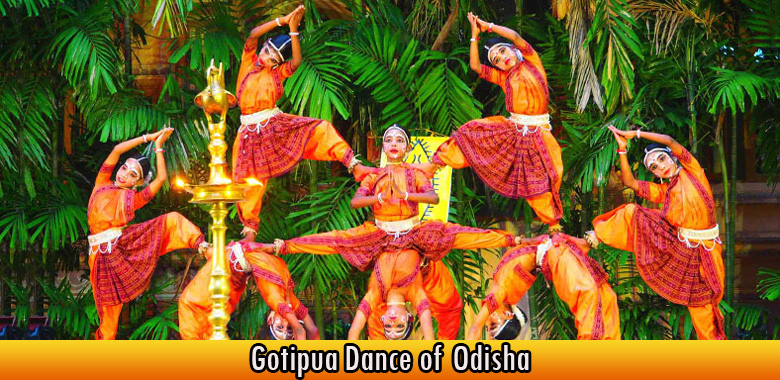In Oriya language, “Goti” means “single” and “Pua” means “boy”. For centuries, the Gotipua dance has been performed in Orissa by young boys who dress up as female to praise Lord Jagannath and Lord Krishna. The actual form of the dance is executed by a group of boys who perform acrobatic figures inspired by the life of Radha & Krishna. The boys start to learn the dance at an early age until the adolescence, when their androgynous look is fading.
The costume and make-up
To transform into graceful feminine dancers, the boys do not cut their hair to make an elaborate hair-do in a knot. Garlands of flowers are woven into the hair. They apply make-up on their face with white and red powder mixed together. Kajal (black eyeliner) is applied around the eyes with a broad outline to give them an elongated look. The Bindi (red dot) is applied on the forehead with a pattern made from sandalwood around it. Traditional paintings adorn the face and are the identity of every dance school.
The dance costume has evolved over time. The traditional dress is a “Kanchula”, bright coloured blouse with shiny embellishment. An apron-like and embroidered silk cloth is tied around the waist like a frill worn around the legs: it is called “nibibandha”. The gotipua dancers have given up their traditional costume due to the influence of modernity. In some cases, they still adhere to the tradition: they use the pattasari made with one piece of tissue around four meters long, which is worn tightly by having equal lengths of material on both sides, and by tying a knot on the navel. Those traditional dresses are often replaced by a new designed cloth easier for dressing.
The dancers wear specially designed jewelry made with beads: necklaces, bracelets, armbands and ear ornaments. The nose piercing jewelry has been replaced nowadays by a painted motive. They add ankle bells to accentuate the beats tapped out by the feet. Palms and soles are painted with a red liquid called “Alta”. The costume, jewelry and bells are sacred items.
History of the Gotipua Dance
In ancient times, the temples of Orissa had female dancers called “Devadasi or Mahari (in Odisha)” who were devoted to Lord Jagannath. The sculptures of the dancers on the bas-reliefs of the famous temples of Orissa (the Sun Temple in Konark and the Jagannath temple in Puri), show the evidence of this very ancient tradition.
Around the 16th century, with the decline of the Mahari dancers, the class of these boy dancers came into existence in Odisha, to carry out the tradition. This was during the time of Bhoi king Rama Chandra Dev, founder of Bhoi dynasty.
The Gotipua dance is in Odissi style, but their technique, costumes and presentation differ from those of the Mahari. The singing is done by the dancers themselves.
It is largely from the Gotipua dance that the present form of Odissi dance has been inspired. Most of the present-day Gurus of Odissi dance (like the famous Guru Kelucharan Mohapatra from Raghurajpur village) were Gotipua in their young days.
The captivating style of Odissi dance is based in tandava (vigorous, masculine) and lasya (graceful, feminine) dance, and has two basic postures:
“Tribhangi” where the body is held with three bends of the head, torso and knees,
and “Chouka”, a square-like stance that symbolizes Lord Jagannath.
The fluidity of the upper torso is characteristic for Odissi, and is often compared to the gentle waves of the sea that forever caress the Odisha beaches.
Comments
comments
